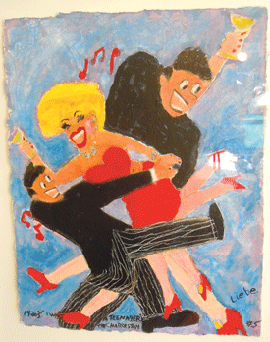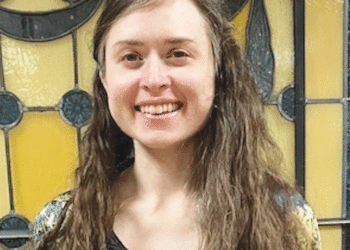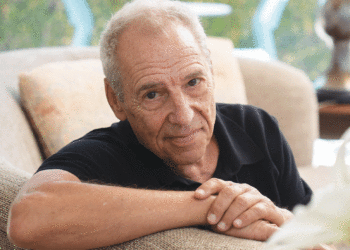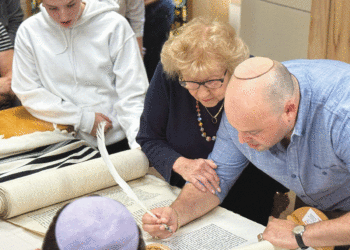Rimon, JHSUM host two-week festival of art and community in North Minneapolis, beginning June 16
By ERIN ELLIOTT BRYAN / Community News Editor
In 2010, the Jewish Historical Society of the Upper Midwest (JHSUM) and Rimon: The Minnesota Jewish Arts Council, an initiative of the Minneapolis Jewish Federation, forged a partnership to host mutual benefits celebrating Jewish arts and culture. Last year’s event, which was held at the home of JHSUM Executive Director Katherine Tane, was “An Afternoon of Art in the Garden” and featured food, wine and works by local artists.
This year, it was Rimon Executive Director David Jordan Harris’ turn to host an event at his home.
“The most interesting thing about my home is, number one, it’s on the near Northside, in the heart of the old Jewish neighborhood. So I thought, let’s lift that up,” Harris told the AJW. “My house is beautiful and it’s a marvelous neighborhood. There are a lot of new initiatives on the Northside that I want to bring to the attention particularly of the Jewish community, many of whom have a historic relationship with this neighborhood.”
Harris said that one thing led to another and the singular event evolved into a two-week festival.
Rimon and JHSUM will host “The Northside Today: Memory, Place, Home, Community,” which will run June 16-29. The festival will feature a juried art exhibit, film screening, artist lecture, arts workshops, music performances, a guided walking tour and a hands-on display of JHSUM’s newest Web exhibit, Placeography.org.
Miraculously, none of the locales that will be part of the festival were damaged by the May 22 tornado, though Harris allowed, “two blocks away, that’s not true.” He and the other festival organizers briefly considered canceling or postponing the events, but agreed to move forward as scheduled.
“I look at it as adding more resonance to this festival,” Harris said. “If we’re not putting the public in harm’s way, this is not the time to be backing away from the Northside.”
 “I was a Teenager,” by the late Lillian Brazman, recalls her passion for the Charleston dance craze of the 1920s. The piece will be included in the juried exhibit titled The Northside Today: Memory, Place, Home, Community. (Photo: Courtesy of Rimon)
“I was a Teenager,” by the late Lillian Brazman, recalls her passion for the Charleston dance craze of the 1920s. The piece will be included in the juried exhibit titled The Northside Today: Memory, Place, Home, Community. (Photo: Courtesy of Rimon)
Harris said the tornado will be integrated into the festival in a constructive way, which will include providing a drawing pad and asking participants to write or draw their own reflections of the damage.
“There’s no overlooking the fact that this took place,” Harris said. “This is an opportunity to really lift up the Northside and bring it to the attention of the public in a way that doesn’t always come. And it fulfills Rimon’s mission to put artists in the center of the community, not at its edges.”
The centerpiece of the festival is The Northside Today: Memory, Place, Home, Community, a juried invitational exhibit featuring more than a dozen Minnesota-based artists, that will be on display at Homewood Studios, 2400 Plymouth Ave. N.
The Northside is a longtime home for immigrant groups and minorities, and many of the featured artists are past or current residents of the neighborhood. Looking at the Northside through the multiple lenses of memory, place, home and community, they have created visual interpretations in painting, textile, photography, digital drawing and sculpture.
“We’re using these as images through which you can enter the Northside, connecting the past with the present,” Harris said.
The artists, who were selected by jurors David Feinberg and Camille Gage, are Sonya Berlovitz, the late Lillian Brazman, Lynn Fellman, Pamela Gaard, Bonnie Heller, Wing Young Huie, Jay Isenberg, Lynda Monick-Isenberg, Kathleen Malecki, Amy Sands and Rochelle Woldorsky.
“The participants in the exhibit are a mixture of folks who still live on the Northside and people who don’t live on the Northside any longer,” Harris said. “Some are Jewish, some aren’t Jewish. Some are very well known professional artists and some are less well-known. It’s a very interesting mix of people.”
Harris first heard about Brazman when her 95-year-old brother-in-law responded to Rimon’s call for Northside art in the American Jewish World. Brazman, who died in 2001, at the age of 90, was born in Ukraine and raised on the Northside. She began painting in her 70s and was a prolific, highly regarded artist whose work spoke to the popular dance, fashions and social movements of much of the 20th century.
Another artist featured in the exhibition is costume designer Berlovitz, whose handwoven piece is a visual timeline of the many ethnic groups, races and religions that have comprised the Northside community from the 1950s to the present.
“The truth of the matter is that the Northside has always been a channel for immigrants and minorities,” Harris said. “The Jewish community participated in that part of town in that spirit and other immigrant groups do it to this day. It has never changed in that regard, even if the specific communities who make it up have changed.”
In conjunction with the exhibit, Feinberg, a professor of art at the University of Minnesota and creator of the acclaimed “Voice to Vision” project, will lead an adult arts workshop on memory and place 7 to 9 p.m. Monday, June 20 at Homewood Studios. The cost is $18 and reservations are required.
Two benefit events will include a screening of filmmaker Daniel Bergin’s new documentary, Cornerstones: A History of the Northside, 7 p.m. Thursday, June 16; and a talk by Northside native and nationally known artist Seitu Jones 12 p.m. Sunday, June 26. Both will take place at Harris’ home, 1111 Upton Ave. N., Minneapolis. The cost for each event is $50; to make a reservation, visit: www.jhsum.org.
According to Tane, Bergin’s film picks up where JHSUM’s We Knew Who We Were: Memories of the Minneapolis Jewish North Side left off. The JHSUM documentary covered the history of the Northside up to the 1960s, while Bergin was interested in the 1960s to the present. JHSUM staff is consulting with Bergin on his film, which he is producing in partnership with TPT and the University of Minnesota.
“The Historical Society is excited to be part of making sure this story moves forward and is told today. And it’s through the lens of the history of the Jewish community on the Northside, but it’s spotlighting what’s happened there since most of the Jewish community has moved,” Tane told the AJW.
Following the benefit lunch and talk by Jones on June 26, urban historian Iric Nathanson will lead a free, one-hour walking tour of Plymouth Avenue (meet at 1:15 p.m. at 2400 Plymouth Ave. N.). No reservations are required.
JHSUM has led previous walking tours of the Northside to see buildings and former synagogues, but Nathanson will focus on what happened to Plymouth Avenue during the urban redevelopment of the 1960s and ’70s.
“The festival is a wonderful way for us to say that there’s still much to be gained from looking back at the perspective of knowing where you come from,” Tane said. “To understand the Northside today, you need to understand what it once had been and the forces that were in effect that created the neighborhood that we see now.”
Also on June 26, Homewood Studios director George Roberts will lead a free workshop for teens on memory and place at 12:30 p.m. at UROC, the University of Minnesota’s center for community engagement, 2001 Plymouth Ave. N. Between 2:30 and 4 p.m., musical performances, an exhibit of the teen and adult workshop artists, information about the Northside’s cultural organizations and a hands-on display of Placeography.org will be offered.
Placeography.org is a site similar to Wikipedia that highlights places and allows users to contribute photos and memories. Staff will be available to showcase the site, which includes a section about the Northside, and to assist users in uploading their unique remembrances.
“We’re looking for the sorts of things that we call the fabric of history, the thread, the stories that make a neighborhood come alive off the page,” Tane said.
Harris referred to the festival as a “personal invitation” for all to visit. Though not a native of the Twin Cities, Harris, who moved into his newly restored home two years ago, knows there is an “enormous sentiment around the Northside.”
“It’s significant that the two chief events are in my home. It’s meant to say, come to my home, come to my neighborhood,” he said. “For those who have any roots in the Northside, I think it will be fascinating. I think that each of these artists… will address something that is in their own heart, that speaks to the Northside — not only as it was, but as it developed into its new form.”
***
For information on “The Northside Today: Memory, Place, Home, Community,” visit: www.rimonmn.org and www.jhsum.org, or contact Harris at 952-381-3449 or: rimon@sabesjcc.org.
(American Jewish World, 6.10.11)









 “I was a Teenager,” by the late Lillian Brazman, recalls her passion for the Charleston dance craze of the 1920s. The piece will be included in the juried exhibit titled The Northside Today: Memory, Place, Home, Community. (Photo: Courtesy of Rimon)
“I was a Teenager,” by the late Lillian Brazman, recalls her passion for the Charleston dance craze of the 1920s. The piece will be included in the juried exhibit titled The Northside Today: Memory, Place, Home, Community. (Photo: Courtesy of Rimon)










Comments 0